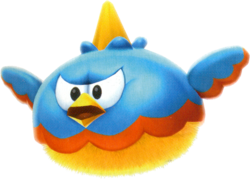Flaptack: Difference between revisions
(→Trivia) |
No edit summary Tag: Mobile edit |
||
| (56 intermediate revisions by 34 users not shown) | |||
| Line 1: | Line 1: | ||
{{ | {{species infobox | ||
|image=[[File:Flaptack.png|250px]]<br>Artwork from ''Super Mario Galaxy 2'' | |||
|image=[[ | |first_appearance=''[[Super Mario Galaxy 2]]'' ([[List of games by date#2010|2010]]) | ||
|first_appearance=''[[Super Mario Galaxy 2]]'' ([[2010]]) | |comparable=[[Flaptor]] | ||
}} | }} | ||
A '''Flaptack''' is | A '''Flaptack'''<ref>{{cite|author=Browne, Catherine|title=''Super Mario Galaxy 2: PRIMA Official Game Guide''|location=Roseville|publisher=Random House Inc|date=May 23, 2010|page=26|isbn=978-0-30746-907-6}}</ref> is an [[List of enemies|enemy]] in ''[[Super Mario Galaxy 2]]''. The "flap" part of its name refers to its bird-like appearance, and the "tack" part refers to the sharp spike on its head. The enemy's name is also a pun on "flapjack," another name for a pancake, referring to the enemy's oblate body and its method of attack by flipping upside down. Flaptacks look like oversized blue birds with yellow spikes on their heads. When a Flaptack spots [[Mario]] or [[Luigi]], it floats around him for a while. After a few seconds, it tries to stab him with its spike on its head. If it misses, it will be stuck on the ground, defenseless. A Flaptack still in the air can be defeated by [[Backward Somersault|backward-somersaulting]] and [[spin]]ning into it, or automatically by luring its slam attack into a [[pit]]. Flaptacks give three [[Star Bit]]s when spun and a [[coin]] when [[jump]]ed on. These enemies can also destroy [[Cloud Mario]] or Cloud Luigi's clouds with their spikes. Flaptacks appear in early galaxies such as the [[Fluffy Bluff Galaxy]] and [[Cloudy Court Galaxy]], but they also appear in later galaxies such as the [[Flash Black Galaxy]]. | ||
==Names in | ==Gallery== | ||
{{ | <gallery> | ||
SMG2 Flaptack Screenshot.png|Screenshot from ''Super Mario Galaxy'' ([[Cloudy Court Galaxy]]) | |||
</gallery> | |||
==Names in other languages== | |||
{{foreign names | |||
|Jap=ピュードン | |Jap=ピュードン | ||
|JapR= | |JapR=Pyūdon | ||
|JapM= | |JapM=Portmanteau of the onomatopoeic terms「ピュー」(''pyū'', "whoosh") and「ドン」(''don'', "boom") | ||
|Ita=Volopiglio | |Ita=Volopiglio | ||
|ItaM= | |ItaM=Masculine form of the verbs ''volare'' ("to fly") and ''pigliare'' ("to seize") | ||
|Ger=Stampfhuhn | |Ger=Stampfhuhn | ||
|GerM= | |GerM=From ''stampfen'' ("to trample") and ''Huhn'' ("chicken") | ||
|Fre=Galliboum | |||
|FreM=From ''gallina'' ("hen" in Spanish) and ''boum'' (onomatopoeic word for "thud") | |||
|SpaE=Piodón | |||
|SpaEM=From "pío" (onomatopoeia for chirping) and part of the Japanese name (in an augmentative form) | |||
}} | |||
==References== | |||
<references/> | |||
{{SMG2}} | {{SMG2}} | ||
[[Category:Birds]] | [[Category:Birds]] | ||
[[Category:Super Mario Galaxy 2]] | [[Category:Aliens]] | ||
[[ | [[Category:Super Mario Galaxy 2 enemies]] | ||
[[ | [[it:Volopigio]] | ||
[[de:Stampfhuhn]] | |||
Latest revision as of 14:01, October 11, 2024
| Flaptack | |||
|---|---|---|---|
 Artwork from Super Mario Galaxy 2 | |||
| First appearance | Super Mario Galaxy 2 (2010) | ||
| |||
A Flaptack[1] is an enemy in Super Mario Galaxy 2. The "flap" part of its name refers to its bird-like appearance, and the "tack" part refers to the sharp spike on its head. The enemy's name is also a pun on "flapjack," another name for a pancake, referring to the enemy's oblate body and its method of attack by flipping upside down. Flaptacks look like oversized blue birds with yellow spikes on their heads. When a Flaptack spots Mario or Luigi, it floats around him for a while. After a few seconds, it tries to stab him with its spike on its head. If it misses, it will be stuck on the ground, defenseless. A Flaptack still in the air can be defeated by backward-somersaulting and spinning into it, or automatically by luring its slam attack into a pit. Flaptacks give three Star Bits when spun and a coin when jumped on. These enemies can also destroy Cloud Mario or Cloud Luigi's clouds with their spikes. Flaptacks appear in early galaxies such as the Fluffy Bluff Galaxy and Cloudy Court Galaxy, but they also appear in later galaxies such as the Flash Black Galaxy.
Gallery[edit]
Screenshot from Super Mario Galaxy (Cloudy Court Galaxy)
Names in other languages[edit]
| Language | Name | Meaning | Notes |
|---|---|---|---|
| Japanese | ピュードン[?] Pyūdon |
Portmanteau of the onomatopoeic terms「ピュー」(pyū, "whoosh") and「ドン」(don, "boom") | |
| French | Galliboum[?] | From gallina ("hen" in Spanish) and boum (onomatopoeic word for "thud") | |
| German | Stampfhuhn[?] | From stampfen ("to trample") and Huhn ("chicken") | |
| Italian | Volopiglio[?] | Masculine form of the verbs volare ("to fly") and pigliare ("to seize") | |
| Spanish (NOE) | Piodón[?] | From "pío" (onomatopoeia for chirping) and part of the Japanese name (in an augmentative form) |
References[edit]
- ^ Browne, Catherine (May 23, 2010). Super Mario Galaxy 2: PRIMA Official Game Guide. Roseville: Random House Inc. ISBN 978-0-30746-907-6. Page 26.
